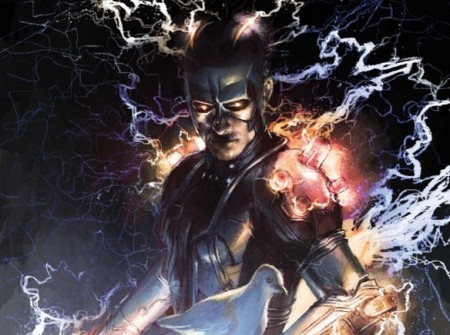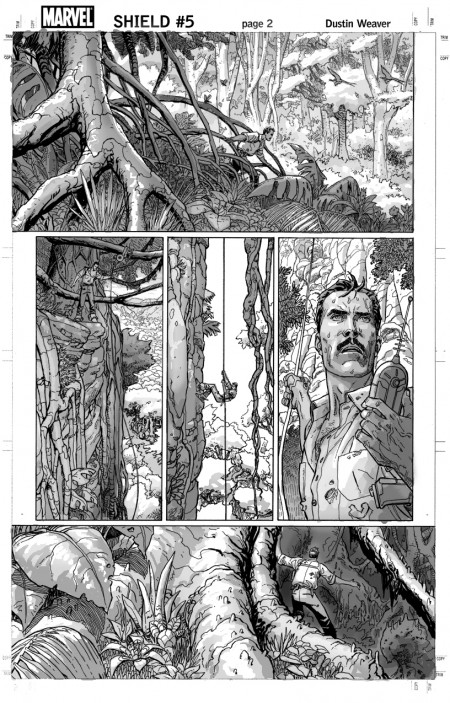Images & Words – S.H.I.E.L.D. #5
[images & words is the comic book pick-of-the-week at OL. equal parts review and diatribe, the post highlights the most memorable/infuriating/entertaining book released that wednesday]
This week’s pick of the comics-litter is S.H.I.E.L.D. #5 by writer Jonathan Hickman and illustrator Dustin Weaver.
If all you care to know is which comic gets the Images & Words accolades, then you can stop reading right now. I offer only my thanks for entertaining my feeble expressions thus far and encourage you to plunk down $3 for this book.
For those of you interested in why this comic gets the nod: S.H.I.E.L.D. #5 affects me. Greatly. In that way that makes met step back and consider both otherworldly possibilities and the unactivated transcendences of inner-space.
Most entertainment I stumble across is amusing and comforting but ultimately vapid. So when a diversion actually manages to strike a chord, resonating deep within the guts of my flesh-vehicle, it is to be commended. Such is the case with Hickman and Weaver’s collaboration.
I’m not going to detail the plot of this series. Because as intrigued as I am by the story, I find myself much more enamored of the subtext. But for the sake of, well, knowing what the fugg is going on, I’ll say this: S.H.I.E.L.D. reimagines the Marvel universe’s organization for which the series as a secret society spanning millenia aimed at ensuring the survival of the Earth. Instead of Nick Fury and the Triskelion, we’ve got Leonardo da Vinci and Isaac Newton vying for control of the High Council while Nostradamus and Leonid try to figure out what’s happened to the Night Machine. Oh, and Howard Stark and Nathaniel Richards are also hunting down the Night Machine, which leads to them being transported thousands of years into the future. Oh, and also, the Star Child is growing both mentally and physically at an exponential rate.
Shit. I know that probably doesn’t make a damn lick of sense if you haven’t read the comic. So if you still want a more in-depth explanation, feel free to look here. But don’t worry, because comprehension of the plot isn’t a prerequisite for understanding why I adore S.H.I.E.L.D.
This comic book is powerful because of accurately it depicts the predicament of pushing oneself to the absolute limit. The human mind is capable of the most amazing feats if granted the proper environment. Unfortunately, such an environment can only be created by sacrificing the very comforts most seek to attain. Hickman and Weaver deliver a scene in which Howard Stark and Nathaniel Richards discuss the difficulty of leaving their families to pursue riskier goals:
RICHARDS: No–that’s not what–how did you break it to your son? That you’re never coming home again?
STARK: I didn’t. They’re going to fake my death. I believe an automobile crash is the plan that was eventually settled on…It’s for the best. It is. I love my family…I do, Nathaniel. But they covet my time, seeking every spare moment for themselves–When I know I have more important things to do than play “father.” I felt myself growing more resentful so I chose to leave before it became something more. It was the logical choice.
RICHARDS: It was selfish.
STARK: Yes, I suppose it was that also…
RICHARDS: So, for you, this is about a higher calling, the fate of the world, the future of man and all that?
STARK: No. Well, yes…But, no.
RICHARDS: What then?
STARK: Discovery, Dr. Richards.
Stark is a man driven by the thought of setting precedents, exploring the uncharted, and helping humanity in ways that it doesn’t even realize it needs help. These pursuits can lead to both societal betterment and self-actualization, but come at the cost of dismantling a family. And who knows what type of adverse effects this may cause?
Also at the heart of my admiration for this series is its embracing of unconventional narrative techniques. In this fifth issue, the reader is ushered into several different times. At one point, the story projects several thousands of years into the future; a few pages later, these characters are seen interacting in 1951.
In the comics’ visual highlight, eight pages are set aside to display the transition from 1957-1960. Each year gets a two-page spread, which is then further divided into four segments – the Human Machine, the Star Child, da Vinci, and Isaac Newton as seen in each respective year.
What’s the point of these eight pages? Well, on the one hand they’re gloriously delicious. Stare at them and try to regain your breath. I dare you. But moreover, they illustrate the idea that the monumental developments of history occur over time. Positive or negative, nothing happens overnight (even if it seems to). Both the forces of good and those of evil (da Vinci and Newton, respectively), toil away and ferment and eventually affect the world.
It feels so damn appropriate to award the final Images & Words of 2010 to S.H.I.E.L.D., the series that impressed me more than any other this year. You owe it to yourself, as a fan of the paneled page, to not only buy this issue but the previous four as well.





